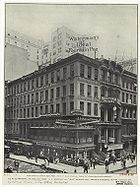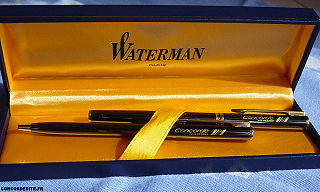
Waterman pens
Encyclopedia

Pen
A pen is a device used to apply ink to a surface, usually paper, for writing or drawing. Historically, reed pens, quill pens, and dip pens were used, with a nib of some sort to be dipped in the ink. Ruling pens allow precise adjustment of line width, and still find a few specialized uses, but...
company is a major manufacturer of fountain pen
Fountain pen
A fountain pen is a nib pen that, unlike its predecessor the dip pen, contains an internal reservoir of water-based liquid ink. The pen draws ink from the reservoir through a feed to the nib and deposits it on paper via a combination of gravity and capillary action...
s. Established in 1884 in New York City by Lewis Edson Waterman
Lewis Waterman
Lewis Edson Waterman , born in Decatur, New York, was the inventor of the capillary feed fountain pen and the founder of the Waterman pen company....
, it is one of the few remaining first-generation fountain pen companies, as Waterman S.A.. It is currently owned by Newell Rubbermaid
Newell Rubbermaid
Newell Rubbermaid is a global marketer of consumer and commercial products including such well-known brands as Rubbermaid food storage, home organization, and refuse container products; Sharpie, PaperMate, Parker and Waterman writing instruments; Calphalon gourmet cookware; Goody beauty and...
.
History
The initial years of Waterman's involvement in pen manufacturing are unclear. The earliest records of reservoir pens date back to the tenth century, with the oldest surviving examples dating back to the 18th. Waterman's improvements on basic pen design and aggressive marketing played a vital role in making the fountain pen a mass-market object.The key novelty feature of Waterman's first fountain pens was the feed, for which his first pen-related patent was granted in 1884. From the beginning, competition in the fountain pen industry was fierce, both in the marketplace and the courtroom. Despite later company literature that depicts Lewis E. Waterman as a golden-hearted innocent, all evidence indicates that he was a tough, savvy, and innovative businessman.

As the 20th century wore on Waterman's conservatism allowed its younger and more innovative competitors to gain market share -- Parker, Sheaffer
Sheaffer
Sheaffer is a pen company that manufactures writing instruments including ballpoint, fountain and rollerball pens and mechanical pencils. It is famous for its “school” lineup of fountain pens, as well as calligraphy sets....
, and Wahl-Eversharp, in particular. By the later 1920s, Waterman was playing catch-up; it continued to struggle through and beyond World War II before finally shutting down in 1954.
Waterman's French subsidiary, Waterman Jif (later Waterman S.A.), continued to prosper and eventually absorbed what remained of the American company and its British arm. Successfully weathering the challenge of the ballpoint pen, it was acquired by Sanford
Sanford (writing products)
Sanford L.P., is a Newell Rubbermaid company based in Oak Brook, Illinois, USA. Sanford is the largest writing products manufacturer in the world. It is primarily known for manufacturing Sharpie, Paper Mate, and Prismacolor products.-History:...
, a division of Newell Rubbermaid
Newell Rubbermaid
Newell Rubbermaid is a global marketer of consumer and commercial products including such well-known brands as Rubbermaid food storage, home organization, and refuse container products; Sharpie, PaperMate, Parker and Waterman writing instruments; Calphalon gourmet cookware; Goody beauty and...
, in 2001, owner of The Parker Pen Company.
Pens
Early Waterman pens were made of hard rubber and were equipped with 14K gold nibs. From early on, precious metal trim and overlays were offered. Many are still in use today, and their nibs are prized for their smoothness and flexibility.Waterman's high production volume from c. 1900 on means that vintage examples are comparatively easy to find today. The most common models from the hard rubber era are the #12 slip-cap eyedropper, the #52 screw-cap lever-filler, and the #42 retracting-nib safety pen. Waterman adopted celluloid comparatively late, with the advent of the Patrician and Lady Patricia in 1929. Though largely ignored by present-day collectors, the Waterman C/F of 1953 introduced the modern plastic ink cartridge.
A few pens of Waterman S.A. are: the Edson, the Philéas
Waterman Phileas
Waterman Philéas is a series of writing instruments including fountain pens, rollerballs, ballpoints and pencils produced by the Waterman pen company. It is well-known because of its good price-quality ratio and is therefore often recommended for novice fountain pen users and collectors...
, the Hémisphère
Waterman Hemisphere
The Waterman Hémisphère is a pen produced by the French pen company Waterman.The Hémisphère is a light pen that has a cigar shaped barrel with a beveled top and usual Waterman clip. It comes in many colours , a lacquer finish, or a brushed chrome or gold finish. The clip comes in chrome or 24-karat...
, the Expert, the Harmonie, the Charleston, the Ici et Là, the Audace, the Sérénité, the Liaison and the Carène. The Man 100 was released in 1983 for the 100th anniversary of the company; François Mitterrand
François Mitterrand
François Maurice Adrien Marie Mitterrand was the 21st President of the French Republic and ex officio Co-Prince of Andorra, serving from 1981 until 1995. He is the longest-serving President of France and, as leader of the Socialist Party, the only figure from the left so far elected President...
was known for carrying two wherever he went.

